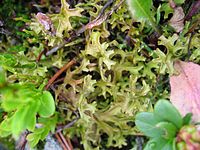- Iceland moss
-
Iceland moss 
Scientific classification Kingdom: Fungi Division: Ascomycota Class: Lecanoromycetes Order: Lecanorales Family: Parmeliaceae Genus: Cetraria Species: C. islandica Binomial name Cetraria islandica
(L.) Ach.Iceland moss (Cetraria islandica) is a lichen whose erect or ascending foliaceous habit gives it something of the appearance of a moss, whence probably the name. It is often of a pale chestnut color, but varies considerably, being sometimes almost entirely greyish white; and grows to a height of from 3 to 4 in., the branches being channelled or rolled into tubes, which terminate in flattened lobes with fringed edges.
It grows abundantly in the mountainous regions of northern countries, and it is specially characteristic of the lava slopes and plains of the west and north of Iceland. It is found on the mountains of north Wales, north England, Scotland and south-west Ireland. In North America its range extends through Arctic regions, from Alaska to Newfoundland, and south in the Rocky Mountains to Colorado, and to the Appalachian Mountains of New England.
As met with in commerce it is a light-grey harsh cartilaginous body, almost destitute of color, and having a slightly bitter taste. It contains about 70% of lichenin or lichen-starch, a body isomeric with common starch, but wanting any appearance of structure. It also yields a peculiar modification of chlorophyll (called thallochlor), fumaric acid, lichenostearic acid, and cetraric acid (to which last it owes its bitter taste). It forms a nutritious and easily digested amylaceous food, being used in place of starch in some preparations of cocoa. It also contains lichesterinic acid and protolichesterinic acids
It is not, however, in great demand, and even in Iceland it is only occasionally used to make folk medicines,[1] and in a few traditional dishes. In earlier times, it was much more widely used in breads, porridges, soups etc.[2] Cetraric acid or cetrarin, a white micro-crystalline powder with a bitter taste, is readily soluble in alcohol, and slightly soluble in water and ether. It has been recommended for medicinal use, in doses of 2 to 4 grains (0.1 to 0.25 grams), as a bitter tonic and aperient. It is traditionally used to relieve chest ailments.[3]
Gallery
-
Engraving of Cetraria islandica - Islandslav.jpga from the 18th century botanical work Flora Danica
References
 This article incorporates text from a publication now in the public domain: Chisholm, Hugh, ed (1911). Encyclopædia Britannica (11th ed.). Cambridge University Press.
This article incorporates text from a publication now in the public domain: Chisholm, Hugh, ed (1911). Encyclopædia Britannica (11th ed.). Cambridge University Press.- ^ Cetraria islandica at Plants for the Future
- ^ Iceland Recipe
- ^ Iceland Moss
External links
Taxonomy of the Lichen families Show all lichen genera Ascomycota ArthoniomycetesArthonialesArthoniaceae • Chrysothricaceae • Melaspileaceae • RoccellaceaeCapnodiaceaeDacampiaceae • XanthopyreniaceaeEpigloeaceae • Arthopyreniaceae • Didymosphaeriaceae • Lichenotheliaceae • Microthyriaceae • Mycosphaerellaceae • Naetrocymbaceae • Parmulariaceae • Pseudoperisporiaceae • Pyrenotrichaceae • ProtothelenellaceaeChaetothyriomycetidaeHerpotrichiellaceaePyrenulalesMonoblastiaceae • Pyrenulaceae • Requienellaceae • TrypetheliaceaeVerrucarialesAdelococcaceae • VerrucariaceaeStrigulaceaeMycocaliciaceae • SphinctrinaceaeAcarosporomycetidaeAcarosporalesAcarosporaceaeLecanoromycetidaeLecanoralesAnziaceae • Arthrorhaphidaceae • Biatorellaceae • Caliciaceae • Candelariaceae • Cetradoniaceae • Cladoniaceae • Crocyniaceae • Dactylosporaceae • Gypsoplacaceae • Haematommataceae • Lecanoraceae • Lecideaceae • Loxosporaceae • Megalariaceae • Megalosporaceae • Mycoblastaceae • Ophioparmaceae • Parmeliaceae • Physciaceae • Pilocarpaceae • Porpidiaceae • Psoraceae • Ramalinaceae • Rhizocarpaceae • Stereocaulaceae • SphaerophoraceaePeltigeralesCoccocarpiaceae • Collemataceae • Pannariaceae • Lobariaceae • Nephromataceae • Peltigeraceae • PlacynthiaceaeRhizocarpalesCatillariaceaeTeloschistalesLetrouitiaceae • Microcaliciaceae • TeloschistaceaeBrigantiaeaceae • Coniocybaceae • Fuscideaceae • Phlyctidaceae • Umbilicariaceae • VezdaeaceaeAgyrialesAgyriaceae • Anamylopsoraceae • SchaereriaceaeCoenogoniaceae • GyalectaceaeGomphillaceae • Graphidaceae • Odontotremataceae • Solorinellaceae • Stictidaceae • ThelotremataceaePertusarialesIcmadophilaceae • Megasporaceae • PertusariaceaeTrichothelialesPorinaceaeArctomiaceae • HymeneliaceaeHelotiaceae • HyaloscyphaceaeLichinomycetesLichinalesGloeoheppiaceae • Heppiaceae • Lichinaceae • PeltulaceaeNitschkiaceaeBionectriaceae • Nectriaceae • NiessliaceaeHyponectriaceaeObryzaceaeLahmialesLahmiaceaeAspidotheliaceae • Mastodiaceae • Thelenellaceae • Baeomycetaceae • Coccotremataceae • ThelocarpaceaeBasidiomycota AthelialesAtheliaceae • LepidostromataceaeTremellomycetidaeTremellalesSyzygosporaceae • TremellaceaeAtractiellalesChionosphaeraceaePlatygloeaceaeReferences - Anderson, Heidi L. and Stefan Ekman. 2005. Disintegration of the Micareaceae (lichenized Ascomycota): a molecular phylogeny based on mitochondrial rDNA sequences. Mycological Research 109(1): 21–30.
- CABI Bioscience Databases. Available online at http://www.indexfungorum.org/.
- Damien Ertz, James D. Lawrey, Masoumeh Sikaroodi, Patrick M. Gillevet, Eberhard Fischer, Dorothee Killmann, and Emmanuël Sérusiaux. 2008. A new lineage of lichenized basidiomycetes inferred from a two-gene phylogeny: The Lepidostromataceae with three species from the tropics. American Journal of Botany 95(12): 1548–1556.
- Ekman, Stefan, Heidi L. Andersen, and Mats Wedin. 2008. The limitations of ancestral state reconstruction and the evolution of the ascus in the Lecanorales (lichenized Ascomycota). Systematic Biology 57(1): 141–156.
- Ekman, Stefan. 2001. Molecular phylogeny of the Bacidiaceae (Lecanorales, lichenized Ascomycota). Mycological Research 105(7): 783-797.
- Grube, Martin and Katarina Winka. 2002. Progress in understanding the evolution and classification of lichenized ascomycetes. Mycologist 16(2): 67-76.
- Liu , Yajuan J. and Benjamin D. Hall. 2004. Body plan evolution of ascomycetes, as inferred from an RNA polymerase II phylogeny. Proceedings of the National Academy of Sciences 101(13): 4507-4512.
- Schmitt I, Yamamoto Y, Lumbsch HT. 2006. Phylogeny of Pertusariales (Ascomycotina): Resurrection of Ochrolechiaceae and new circumscription of Megasporaceae. Journal of the Hattori Botanical Laboratory 100: 753-764.
- Staiger, Bettina, Klaus Kalb, and Martin Grube. 2006. Phylogeny and phenotypic variation in the lichen family Graphidaceae (Ostropomycetidae, Ascomycota). Mycological Research 110: 765-772.
Categories:- Parmeliaceae
- Lichens
-
Wikimedia Foundation. 2010.





